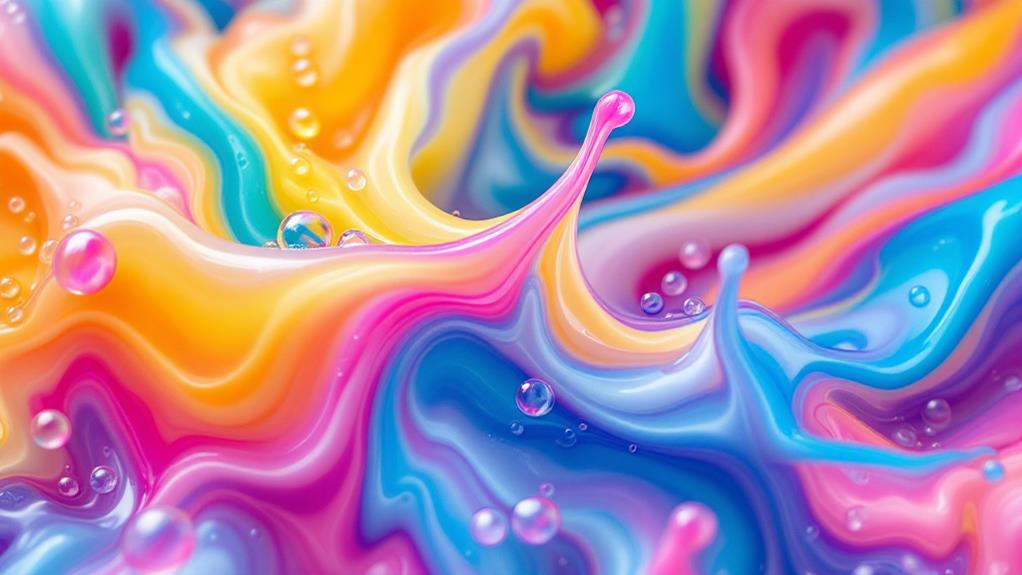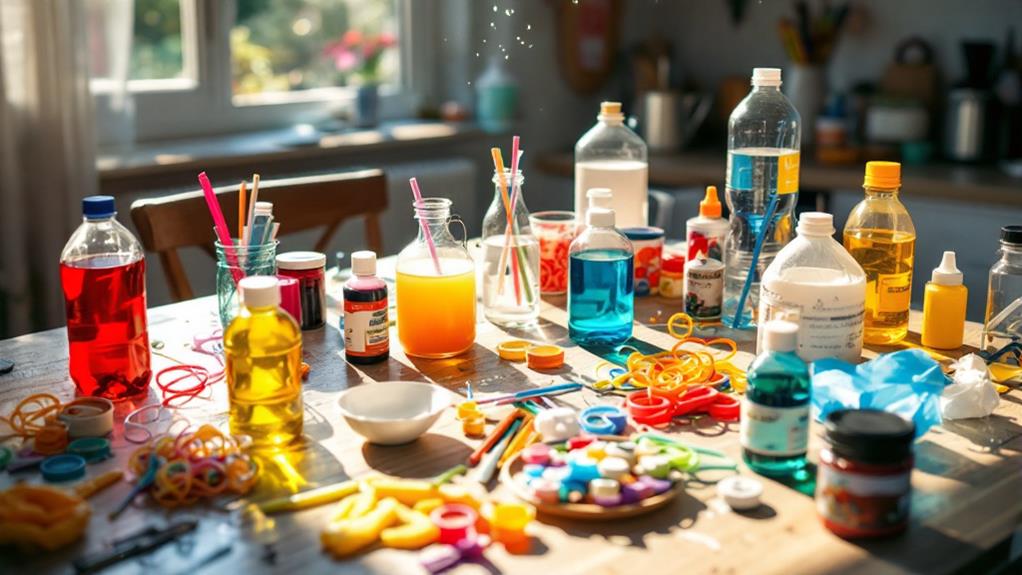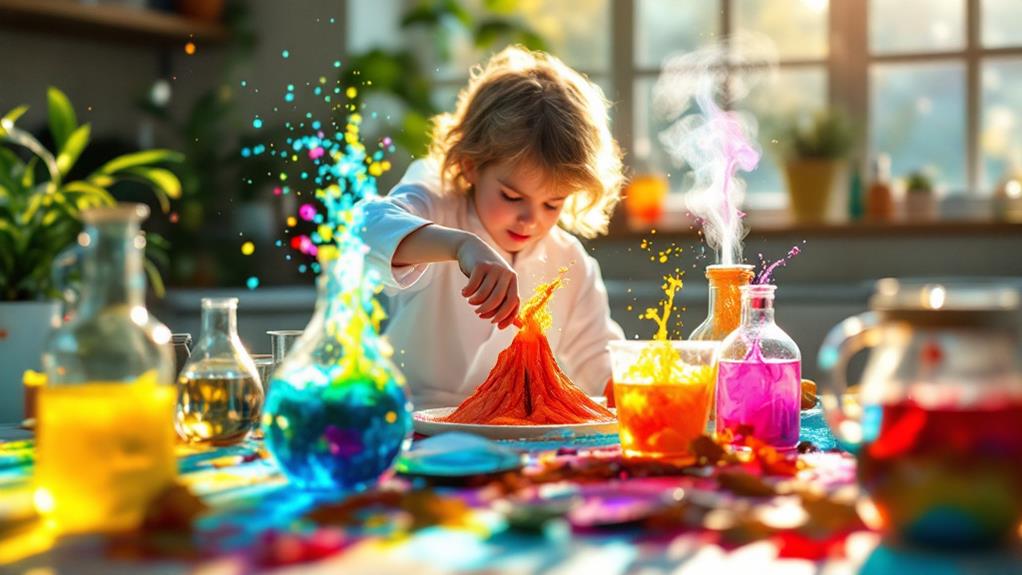The Science Behind Slime: Why It’s More Than Just Fun Goo

You might think slime is just sticky fun, but there's a lot of science bubbling beneath the surface. When you mix glue with borax, a chemical reaction kicks off, forming a flexible polymer network. These polymers give slime its stretchy, gooey charm. Plus, it behaves as a non-Newtonian fluid, meaning its thickness changes with pressure. This hands-on experience lets you observe properties like elasticity and viscosity. It's not just play; it's an educational tool that improves dexterity and understanding of scientific concepts. Explore deeper, and you'll find there's more to slime than meets the eye.
The Chemistry of Slime
In the intriguing world of slime, chemistry plays a starring role in transforming simple ingredients into a stretchy, gooey delight. As you plunge into the history of slime, you'll find that it's not just a modern phenomenon. The origins date back to the 1970s when toy manufacturers initially harnessed the enthralling power of slime. Since then, it's evolved into countless varieties, each providing a unique twist on the original concept.
When you mix basic household items like glue and borax, you're witnessing a chemical reaction that's both simple and complex. The glue contains polyvinyl acetate, a polymer that, when combined with borax, forms a cross-linked structure. This reaction is what gives slime its stretchy and pliable nature. It's fascinating to see how varying the ingredients can create different slime varieties, from the classic stretchy type to fluffy, glittery, or even magnetic slimes.
Investigating the chemistry behind slime lets you appreciate its diversity. With just a few adjustments, you can create a personalized slime with distinct textures and colors. Understanding these chemical processes not only improves your slime-making skills but also deepens your appreciation for this delightful substance.
Understanding Non-Newtonian Fluids
Imagine holding a blob of slime in your hands; it's a perfect example of a non-Newtonian fluid. Unlike water, which flows consistently, slime's flow changes based on the pressure you apply. This is the essence of non-Newtonian behavior—fluids that don't follow Newton's law of viscosity. When you squeeze slime, it feels solid, but let it rest, and it oozes like a liquid.
In the world of fluid dynamics, understanding how non-Newtonian fluids behave is essential. These fluids don't have a constant viscosity; instead, their viscosity adjusts with stress or strain. For instance, when you stretch or stir slime, it behaves differently than when you let it sit undisturbed. This variable viscosity makes non-Newtonian fluids fascinating and useful in different applications.
The Role of Polymers

Ever wonder what gives slime its unique texture and behavior? It all comes down to the magic of polymers. Polymers are long chains of repeating molecules. In slime, these polymer structures play an essential role. When you mix ingredients like glue (a common slime base) with an activator like borax, you're triggering fascinating molecular interactions. Glue contains polyvinyl acetate, a polymer that, when combined with water, begins to form flexible chains.
Adding borax introduces borate ions, which act as a cross-linker. This means they connect these polymer chains, creating a network that's both stretchy and sticky. These cross-linked polymer structures are what give slime its signature elasticity and gooeyness. As you knead the slime, you can feel the polymer chains sliding over each other, making it both a tactile and sensory delight.
Understanding these molecular interactions helps you appreciate why slime behaves the way it does. It's not just a matter of mixing ingredients; it's about creating a network of polymers that interact on a molecular level. So, the next time you play with slime, remember it's science at work, transforming simple components into something truly remarkable.
Exploring Viscosity in Slime
While polymers and their cross-linking give slime its stretchy and sticky characteristics, another key factor in its behavior is viscosity. Viscosity refers to a fluid's resistance to flow. When you play with slime, you're actually observing its viscosity in action. Slime's consistency can range from runny to thick, depending on the ingredients and how they interact. The thicker the slime, the higher its viscosity.
To measure viscosity, you don't need fancy equipment. You can perform simple experiments at home. For instance, let the slime ooze through your fingers, and notice how fast or slow it moves. This is a basic way of gauging its viscosity. The slower it moves, the higher its viscosity. Another method involves using a spoon to stir the slime and observing the resistance you feel.
Understanding viscosity measurements helps you tweak the slime consistency to your liking. Want it thicker? Add more activator. Prefer it runnier? Add more base like glue or water. By experimenting with these adjustments, you can create a slime that flows just the way you want, turning this fun goo into a hands-on science lesson.
Elasticity and Stretchability

As you investigate the enchanting domain of slime, you'll find that elasticity and stretchability play crucial roles in its appeal. These slime properties not only contribute to the sensory experience but also open doors for playful experimentation. When you stretch slime, you're engaging with its unique ability to elongate without breaking, a feature that fascinates both children and adults. This stretchability stems from the polymer chains within the slime, which can extend and retract, making the material feel almost alive in your hands.
When you experiment with slime, you can tweak its elasticity by adjusting ingredients like glue and activator. Adding more glue generally increases stretchability, while more activator tightens the polymer network, leading to a firmer, less stretchy slime. Through playful experimentation, you uncover how these adjustments affect the slime's properties, giving you control over the final texture and performance.
There's an undeniable satisfaction in pulling and stretching slime, watching how it responds to your movements. This interaction is not just fun; it's a hands-on way to learn about physical properties. So, next time you make slime, focus on its elasticity and stretchability, and enjoy the creative process.
Chemical Reactions Explained
When you investigate the chemistry of slime, the magic lies in the fascinating chemical reactions at play. Slime's origins trace back to its intriguing history, where it evolved from a playful curiosity to a staple of sensory play. This gooey substance is created through a reaction between polyvinyl alcohol (found in school glue) and a borate ion (from borax or other activators). When these ingredients mix, they form a flexible polymer network, giving slime its unique texture.
In simpler terms, the borate ions connect the long polymer chains of the glue, transforming the liquid into a semi-solid, stretchable material. This reaction is a classic example of a cross-linking process in chemistry, where the glue's molecules are linked together in a new structure. It's this structure that provides slime's delightful balance between solid and liquid states, making it an engaging medium for sensory play.
As you knead and stretch slime, you're witnessing a dynamic process where the bonds are constantly breaking and reforming. This constant change is what makes slime feel so enchanting in your hands, offering a tactile experience that encourages investigation and learning without you even realizing it.
Educational Benefits of Slime

Understanding the chemical reactions behind slime not only sparks curiosity but also opens the door to its educational benefits. When you engage with slime, you immerse yourself in sensory play that stimulates multiple senses. The gooey texture, lively colors, and sometimes even scents make it a full sensory experience. Through this hands-on interaction, you can investigate scientific concepts like viscosity and elasticity in a way that's both fun and memorable.
But slime isn't just about wowing your senses; it also plays a vital role in developing fine motor skills. As you knead, stretch, and mold the slime, you're strengthening the small muscles in your hands and fingers. This kind of activity is especially beneficial for young children who are still honing their dexterity. It aids in tasks such as writing, buttoning shirts, and tying shoelaces.
Moreover, slime encourages problem-solving and creative thinking. When you manipulate slime, you're experimenting with its properties, which fosters an inquisitive mindset. You'll find yourself asking questions, making predictions, and testing outcomes. This active engagement lays a solid foundation for future scientific learning, making slime more than just a gooey pastime—it's a gateway to exploration.
DIY Slime Experiments
Creating your own slime experiments at home can be a fun and educational adventure. It's an opportunity to investigate science while engaging in sensory play. You can mix different ingredients to create a variety of slime colors and textures, providing a hands-on learning experience. These experiments allow you to plunge into the basics of chemistry and physics, uncovering how different substances interact and change.
Here's a simple guide to get you started:
- Gather Your Supplies: You'll need glue, baking soda, contact lens solution, and food coloring. The colors you choose can evoke different emotions and themes, turning your slime into a lively masterpiece.
- Mix the Ingredients: Combine the glue and baking soda, then add the contact lens solution. Watch as the mixture transforms into slime, a process that illustrates the concept of polymers.
- Add Color and Texture: Incorporate food coloring to create dazzling slime colors. Try adding glitter or beads for extra sensory play. This step encourages creativity and experimentation.
- Investigate Sensory Play: Feel the slime's stretchiness and squishiness. Notice how the colors mix and change, offering a full sensory experience that's both relaxing and stimulating.



